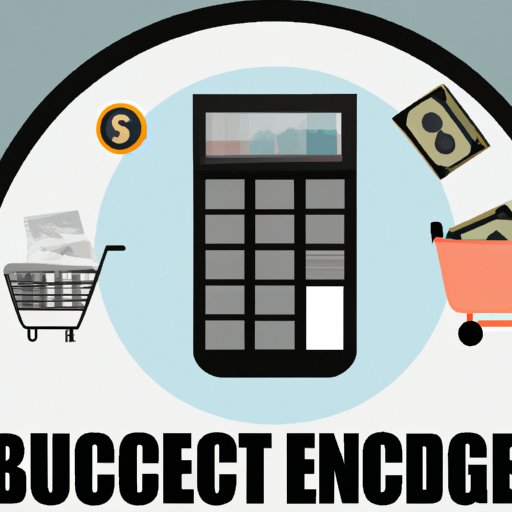Introduction
Launching an ecommerce business is an exciting venture that has the potential to be highly profitable. However, it’s important to understand the costs associated with starting an online store in order to ensure success. This article will provide an overview of the start-up costs associated with ecommerce businesses, as well as strategies for reducing these costs and accessing financing.
Calculating Start-up Costs for an Ecommerce Business
When calculating the cost of starting an ecommerce business, there are several key factors to consider. These include assessing the cost of goods sold, establishing fulfillment and delivery costs, building a website, setting up payment processing, and estimating tax obligations.
Assessing the Cost of Goods Sold
The cost of goods sold (COGS) includes the cost of producing or acquiring the products or services offered by the business. When calculating COGS, it’s important to factor in the cost of raw materials, labor, shipping, and other overhead expenses associated with producing or purchasing products for sale. Additionally, it’s important to account for any discounts received from suppliers or vendors, as well as the cost of inventory storage and management.
Establishing Fulfillment and Delivery Costs
Fulfillment and delivery costs refer to the costs associated with packing and shipping orders to customers. These costs can vary significantly depending on the size and weight of the items being shipped, as well as the distance they are traveling. It’s also important to factor in the cost of returns, as well as any additional fees charged by carriers.
Building a Website
Creating a website is essential for any ecommerce business, as it provides customers with an easy way to browse and purchase products. The cost of designing and building a website will depend on the complexity of the design, the features and functionality desired, and the platform chosen. Additionally, it’s important to factor in the cost of hosting and maintaining the site.
Setting up Payment Processing
In order to accept payments from customers, an ecommerce business must set up a payment processor. This typically involves signing up for an account with a payment gateway provider, such as PayPal, Stripe, or Authorize.net. There are often fees associated with this service, so it’s important to do research and compare different providers in order to find the most cost-effective option.
Estimating Tax Obligations
Ecommerce businesses must pay taxes on their income, as well as any applicable sales taxes. It’s important to research the tax obligations of the business in advance in order to determine how much should be budgeted for taxes each year. Additionally, it’s important to keep records of all transactions in order to ensure accuracy when filing taxes.

Estimating the Investment Required to Launch an Online Store
Once the costs associated with starting an ecommerce business have been calculated, it’s time to estimate the total investment required to launch the store. This includes identifying potential sources of financing, as well as determining the amount of capital needed.
Identifying Potential Sources of Financing
There are various sources of financing available to entrepreneurs, including loans, grants, and crowdfunding. It’s important to explore all of these options in order to determine which one is the best fit for the business. Additionally, it’s important to read the terms and conditions of any financing carefully in order to ensure that the loan can be repaid according to the agreed upon schedule.
Determining the Amount of Capital Needed
In addition to the initial start-up costs, it’s important to estimate the amount of capital needed to sustain the business until it becomes profitable. This includes budgeting for marketing and advertising, employee training, and future growth. It’s also important to consider any unexpected expenses that may arise, such as legal fees or increased inventory costs.

Budgeting for Ecommerce Success: What You Need to Know
Successful ecommerce businesses are built on sound financial decisions. In order to maximize profits, it’s important to allocate resources for marketing and advertising, invest in employee training, and plan for future growth. Additionally, it’s important to monitor expenses closely and adjust budgets as needed.

The Cost of Starting an Online Storefront
The total cost of starting an ecommerce business varies depending on the type of business and the products or services being offered. Generally speaking, there are both upfront expenses and on-going costs associated with running an online store. Upfront expenses include the cost of goods sold, website design and development, payment processing, and taxes. On-going costs include marketing and advertising, employee wages, inventory management, and customer support.
Financing Your Ecommerce Venture: A Guide
In order to finance an ecommerce venture, there are several options available. These include applying for loans and grants, utilizing crowdfunding, and using personal savings. Each of these options has its own advantages and disadvantages, so it’s important to weigh the pros and cons before making a decision. Additionally, it’s important to research any potential lenders or investors in order to ensure that the terms of the loan or investment are favorable.
How Much Money Do You Need to Start an Ecommerce Business?
The amount of money needed to start an ecommerce business depends on several factors, including the type of business, the products or services offered, and the scope of the venture. Generally speaking, the cost of starting an ecommerce business ranges from a few hundred dollars to tens of thousands of dollars. In order to reduce upfront costs, it’s important to focus on streamlining operations and leveraging existing resources.
Conclusion
Starting an ecommerce business requires a significant investment. In order to calculate the cost of launching an online store, it’s important to assess the cost of goods sold, establish fulfillment and delivery costs, build a website, set up payment processing, and estimate tax obligations. Additionally, it’s important to identify potential sources of financing and budget for marketing and employee training. By taking the time to understand the costs associated with starting an ecommerce business and exploring financing options, entrepreneurs can increase their chances of success.
(Note: Is this article not meeting your expectations? Do you have knowledge or insights to share? Unlock new opportunities and expand your reach by joining our authors team. Click Registration to join us and share your expertise with our readers.)
